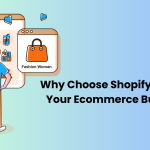Are you on the verge of launching an Ecommerce website / app but are unaware of the important checklist?
Relax! Launching an ecommerce app could be a hassle. But if you’re equipped with the right set of tools, setting up a profitable online business may come easy-peasy.
Whether you have to navigate through your audience’s interests, or beef up app’s performance; a well-structured ecommerce checklist is all you need.

That’s precisely all that you will learn in this article. Before diving right into the article, let us know why it is crucial to have a checklist at hand while launching an ecommerce app.
Why to Go Over a Quality Assurance Checklist Before Launching an Ecommerce App?
The rise of smartphones and mobile technology has revolutionized the way people shop. This has made ecommerce mobile app development a vital component of any successful online business. Also, ecommerce websites and apps go through rigorous development phases. So, publishing an app without testing could develop faults and bugs in the later stages, hence making the whole process a time-consuming one. If you’re planning to launch your own ecommerce app, it’s crucial to follow a comprehensive checklist to ensure a seamless launch.
In this article, we’ll provide you with a comprehensive checklist of essential steps to help you navigate the process and maximize your app’s chances of success. Let’s start.
Don’t Miss a Beat – Use An All-Inclusive Ecommerce App Checklist
Define Your Target Audience:
Before diving into app development, it’s essential to identify your target audience. Understand their demographics, preferences, and buying behaviors. This information will help shape the design, functionality, and marketing strategies for your ecommerce app.
Conduct Market Research:
Thorough market research is crucial for identifying your competition, understanding market trends, and uncovering gaps or opportunities. Analyze successful ecommerce apps in your niche, evaluate their features, user experience, and pricing strategies. By the end of this step, you would be better at making your app stand out from the competitors.
Develop a Solid App Concept:
You are already aware of your target audience and their needs, now you can craft a clear app concept that solves a specific problem or meets a need. Outline the key features, functionalities, and unique selling points that will differentiate your app from competitors.
Select A Suitable Platform:
Choose if you want to create a native app for Android, iOS, or both platforms. Take into account the tastes of your intended audience, the market share of each platform, and the development resources available. In order to effectively reach and interact with your audience, you must choose the correct platform.
Choose A Well-Suited Technology & Framework
Select your preferred technology and framework to develop your app. It could be Shopify, Weebly, Magento, or BigCommerce etc. Make sure that you choose the one where you can find an expert developer with all details of time to develop, budget, and expertise. While selecting a framework or technology stack, keep in mind your ecommerce features and app functionalities. You can also hire a freelance developer or outsource your mobile app development project, but make sure that the team is well-versed with your idea and the technology you want to work in.
Plan Your App’s Look & Feel / User Experience:
The user experience of an ecommerce application is a significant element to consider. You should plan the colors, font style, font size and other design elements beforehand. An ecommerce website or app should also guide users through the buying process. Think about the app’s interface, search features, product classification, and checkout process. Optimize for simplicity, speed, and ease of use.
Optimize Mobile App Development & Performance:
For user retention and happiness, app performance is essential. Make sure your program works well, loads quickly, and is compatible with a range of hardware and operating systems. Test the app for any bugs, crashes, or performance issues before launch.
Implement Secure Payment Options:
Security is a top priority for any ecommerce app. Integrate secure payment gateways and encryption protocols to protect customer data. Offer a variety of payment options to accommodate different user preferences, including credit cards, digital wallets, and other popular payment methods.
Create Compelling Product Descriptions and Imagery:
High-quality product descriptions and appealing imagery are vital for enticing users to make purchases. Create compelling and educational product descriptions that highlight features, advantages, and differentiating characteristics. Use professional product images that showcase your products in the best possible light.
Implement Analytics and Tracking:
Use analytics tools to measure user behavior, conversions, and performance indicators in your app. This information will provide light on user involvement, popular items, and potential development areas. Use these insights to optimize your app and marketing strategies over time.
Develop a Pre-launch Marketing Plan:
Don’t wait until your app is live to start marketing. Build anticipation and create buzz by implementing a pre-launch marketing strategy. Use social media, email marketing, influencer partnerships, and other channels to generate excitement, grow your email list, and encourage pre-orders or app downloads.
Perform Rigorous Testing:
Test your software meticulously across a variety of platforms, screen sizes, and OSes. To get feedback and find any defects or usability problems that need to be fixed, do user testing. Based on user input and test findings, iterate and improve continuously.
App Store Optimization (ASO):
Optimize your app store listing to improve visibility and increase organic downloads. Research relevant keywords, craft a compelling app title and description, and design attractive app screenshots and icons. Encourage positive reviews and ratings to boost your app’s credibility.
Make Use of Artificial Intelligence (AR):
AR has taken over almost all businesses so incorporating it in your ecommerce app will give an added value to the customers. Customers are likely to shop from AR-enabled apps rather than Non-AR. If you incorporate AR features, it will help you cut product returns too.
Conclusion
Launching an ecommerce app requires careful planning, execution, and attention to detail. You can make sure you cover every necessary component of a successful app launch by using this checklist. To address the changing demands of your target audience, don’t forget to continually analyze app performance, collect user feedback, and adjust your methods. With a well-designed and optimized ecommerce app, you can drive engagement, boost sales, and establish a strong online presence for your business.


.jpeg)


